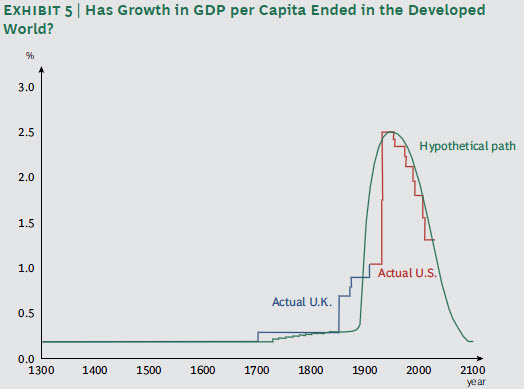Economia

Mais
- Produtividade
The future is here, just not evenly distributed by Alex Tabarrok on October 10, 2015 at 12:07 pm in Economics | Permalink Chiara Criscuolo at HBR discusses a new research report from the productivity...
- Crescimento Econômico E Distribuição
Solow writes, if the economy is growing at g percent per year, and if it saves s percent of its national income each year, the self-reproducing capital-income ratio is s / g (10 / 2 in the example). Piketty suggests that global growth of output...
- Brasil - Expectativas Não Realizadas
Past and Present: Brazil’s Unfulfilled Expectations Industrial Growth and Structural Change: Brazil in a Long-Run Perspective by Dante Aldrighi ([email protected]) and Renato P. Colistete ([email protected]) Abstract: This paper...
- Teorias Da Grande Estagnação
Kenneth Rogoff Innovation Crisis or Financial Crisis? CAMBRIDGE – As one year of sluggish growth spills into the next, there is growing debate about what to expect over the coming decades. Was the global financial crisis a harsh but transitory setback...
- A Futura Da Dívida Pública: Calote
BIS Working PapersNo 300The future of public debt: prospects and implications by Stephen G Cecchetti, M S Mohanty and Fabrizio Zampolli Monetary and Economic Department Abstract Since the start of the financial crisis, industrial country public debt...
Economia
Taxas de crescimento per capita - fim da festa?

Mais
Is U.S. Economic Growth Over? Faltering Innovation Confronts the Six Headwinds
Robert J. Gordon
NBER Working Paper No. 18315
Issued in August 2012
NBER Program(s): DAE EFG PR
Issued in August 2012
NBER Program(s): DAE EFG PR
This paper raises basic questions about the process of economic growth. It questions the assumption, nearly universal since Solow’s seminal contributions of the 1950s, that economic growth is a continuous process that will persist forever. There was virtually no growth before 1750, and thus there is no guarantee that growth will continue indefinitely. Rather, the paper suggests that the rapid progress made over the past 250 years could well turn out to be a unique episode in human history. The paper is only about the United States and views the future from 2007 while pretending that the financial crisis did not happen. Its point of departure is growth in per-capita real GDP in the frontier country since 1300, the U.K. until 1906 and the U.S. afterwards. Growth in this frontier gradually accelerated after 1750, reached a peak in the middle of the 20th century, and has been slowing down since. The paper is about “how much further could the frontier growth rate decline?”
The analysis links periods of slow and rapid growth to the timing of the three industrial revolutions (IR’s), that is, IR #1 (steam, railroads) from 1750 to 1830; IR #2 (electricity, internal combustion engine, running water, indoor toilets, communications, entertainment, chemicals, petroleum) from 1870 to 1900; and IR #3 (computers, the web, mobile phones) from 1960 to present. It provides evidence that IR #2 was more important than the others and was largely responsible for 80 years of relatively rapid productivity growth between 1890 and 1972. Once the spin-off inventions from IR #2 (airplanes, air conditioning, interstate highways) had run their course, productivity growth during 1972-96 was much slower than before. In contrast, IR #3 created only a short-lived growth revival between 1996 and 2004. Many of the original and spin-off inventions of IR #2 could happen only once – urbanization, transportation speed, the freedom of females from the drudgery of carrying tons of water per year, and the role of central heating and air conditioning in achieving a year-round constant temperature.
Even if innovation were to continue into the future at the rate of the two decades before 2007, the U.S. faces six headwinds that are in the process of dragging long-term growth to half or less of the 1.9 percent annual rate experienced between 1860 and 2007. These include demography, education, inequality, globalization, energy/environment, and the overhang of consumer and government debt. A provocative “exercise in subtraction” suggests that future growth in consumption per capita for the bottom 99 percent of the income distribution could fall below 0.5 percent per year for an extended period of decades.
Mais
loading...
- Produtividade
The future is here, just not evenly distributed by Alex Tabarrok on October 10, 2015 at 12:07 pm in Economics | Permalink Chiara Criscuolo at HBR discusses a new research report from the productivity...
- Crescimento Econômico E Distribuição
Solow writes, if the economy is growing at g percent per year, and if it saves s percent of its national income each year, the self-reproducing capital-income ratio is s / g (10 / 2 in the example). Piketty suggests that global growth of output...
- Brasil - Expectativas Não Realizadas
Past and Present: Brazil’s Unfulfilled Expectations Industrial Growth and Structural Change: Brazil in a Long-Run Perspective by Dante Aldrighi ([email protected]) and Renato P. Colistete ([email protected]) Abstract: This paper...
- Teorias Da Grande Estagnação
Kenneth Rogoff Innovation Crisis or Financial Crisis? CAMBRIDGE – As one year of sluggish growth spills into the next, there is growing debate about what to expect over the coming decades. Was the global financial crisis a harsh but transitory setback...
- A Futura Da Dívida Pública: Calote
BIS Working PapersNo 300The future of public debt: prospects and implications by Stephen G Cecchetti, M S Mohanty and Fabrizio Zampolli Monetary and Economic Department Abstract Since the start of the financial crisis, industrial country public debt...
